Compal Communications EB-X500U GPRS User Manual X500 OI English
Compal Communications, Inc. GPRS X500 OI English
Contents
- 1. UserMan1
- 2. UserMan2
- 3. UserMan3
UserMan1
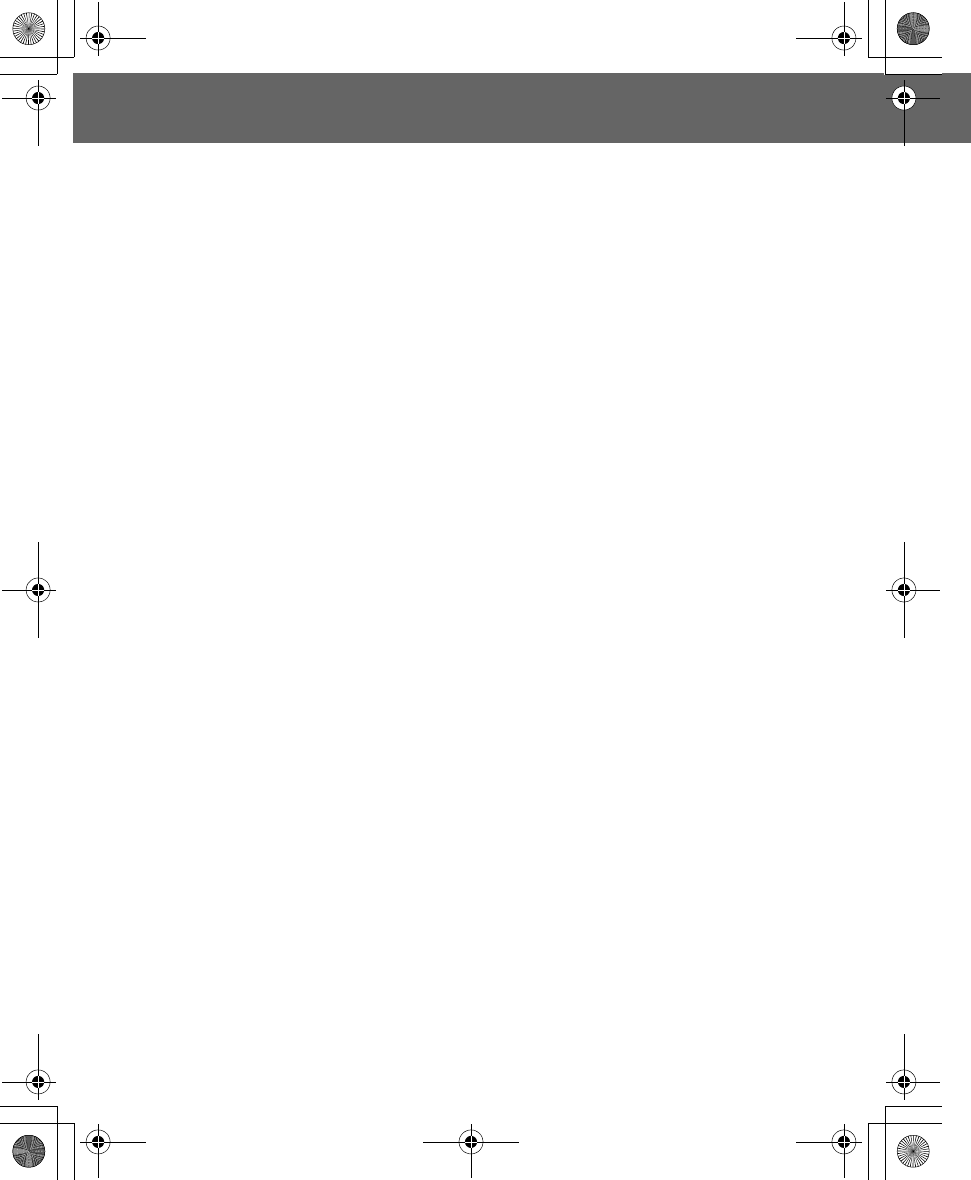
i
Contents
Introduction ........................... 1
Safety Considerations...........1
Care and Maintenance .........6
Appearance............................ 7
Part Names and Functions ... 7
Keys and Symbols ................8
Icons .....................................9
Display ................................10
Getting Started ....................11
Phone Body ........................ 11
Battery Cover......................11
Battery and SIM ..................12
Basic Operations................. 16
Switching ON/OFF..............16
Making a Call ......................16
Incoming Call ......................19
In-call operations ................ 20
Text Entry ...........................27
Exploring the Menus...........29
My Phone ............................. 30
Profiles................................30
Sounds................................ 31
Display ................................34
Slide settings ......................36
Language............................ 37
Auto answer........................ 37
Shortcut key........................37
Menu view...........................38
Phone settings .................... 39
Defaults...............................47
Contacts............................... 48
Contacts list ........................48
Create ................................. 51
Groups ................................52
Memory status ....................53
My numbers ........................53
Voicemail ............................54
Hot key dial .........................54
My Contacts........................55
Games & Apps..................... 56
Games & Apps ................... 56
Settings............................... 57
View Certification................ 58
Browser ................................59
Starting the Browser ........... 59
Browser Menu .................... 59
Bookmarks.......................... 60
Set Profile ........................... 62
Camera .................................63
Key functions ...................... 63
Preview mode..................... 64
Capture mode..................... 68
Messages .............................69
Scheduler .............................79
Viewing the Calendar ......... 79
Creating a reminder............ 79
Reminder list....................... 80
My Media ..............................81
Applications .........................83
Games & Apps ................... 83
Alarms ................................ 83
Voice memo........................ 84
Sound recorder................... 85
Clock................................... 85
Auto power on .................... 86
Auto power off .................... 86
Calculator ........................... 87
Melody composer ............... 88
Trouble Shooting.................90
Important Error Messages..92
Glossary of Terms...............94
Specifications ......................96
Phone (Including Battery) .. 96
Licencing..............................97

ii
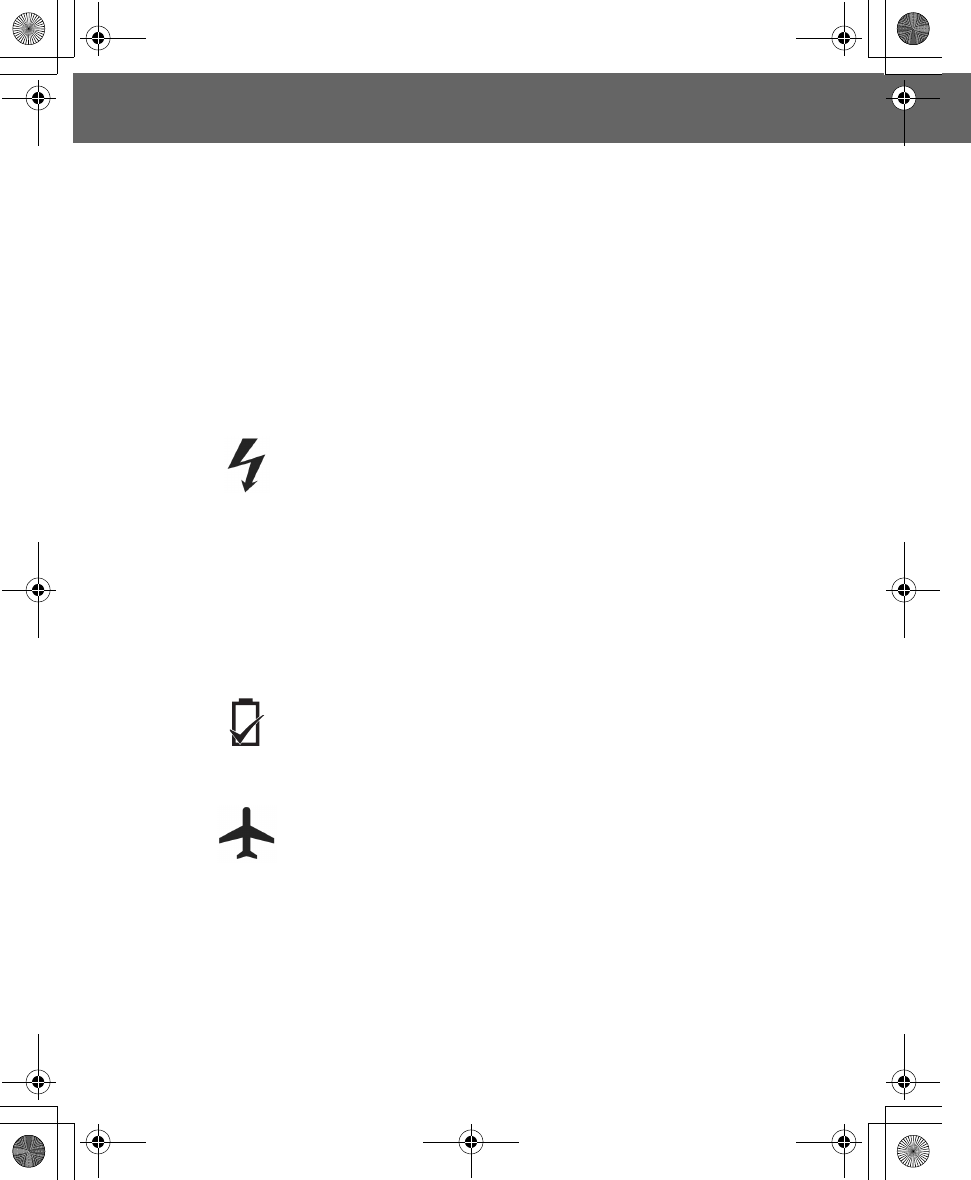
Introduction 1
Introduction
Thank you for purchasing this Panasonic digital cellular phone. This phone is
designed to operate on GSM networks – GSM850 or GSM1900. It also supports
GPRS for packet data connections. Ensure the battery is fully charged before
use.
Safety Considerations
The following information should be read and understood as it provides details
which will enable you to operate your phone in a manner which is both safe to
you and your environment, and conforms to any legal requirements regarding
the use of cellular phones.
This equipment should only be charged with approved charging
equipment. Other usage will invalidate any approval given to
this apparatus and may be dangerous. The use of approved
charging equipment is recommended to ensure optimum
performance and avoid damage to your phone. Ensure the
voltage rating of the Fast Travel Charger is compatible with the
area of use when travelling abroad.
A Fast Travel Charger (EB-CAG60xx*) is supplied with the Main
Kit. Other recommended equipment for charging – Car Charger
(EB-CDG60).
Note* xx identifies the charger region, e.g. CN, EU, UK.
Use of a Battery Pack other than that recommended by the
manufacturer may result in safety hazard.
Switch off your cellular phone when in an aircraft. The use of
cellular phones in an aircraft may be dangerous to the operation
of the aircraft, disrupt the cellular network and may be illegal.
Failure to observe this instruction may lead to the suspension or
denial of cellular phone services to the offender, or legal action
or both.
Power
Battery
Aircraft
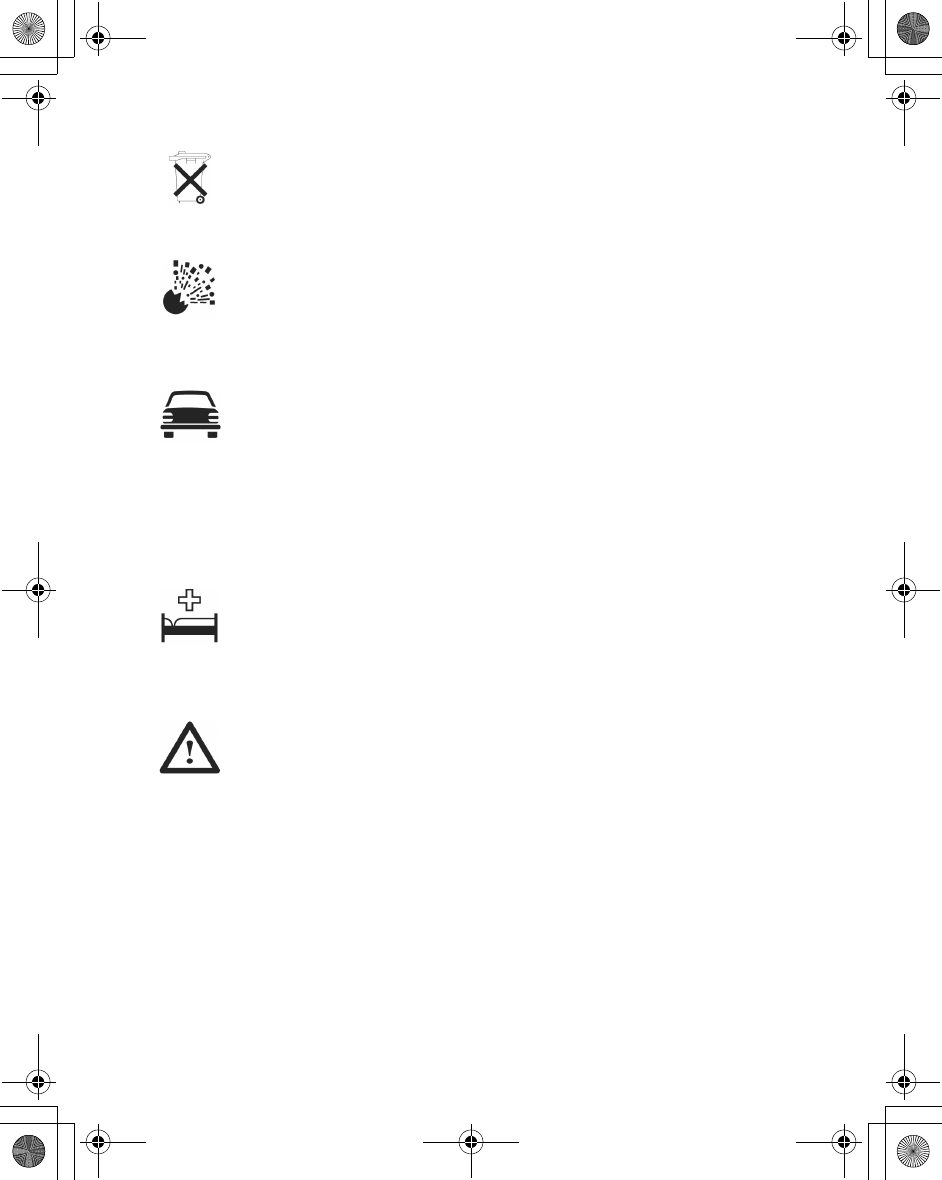
2 Introduction
IDo not incinerate or dispose of the battery as ordinary rubbish.
The battery must be disposed of in accordance with local
legislation and may be recycled.
It is advised not to use the equipment at a refuelling point. Users
are reminded to observe restrictions on the use of radio
equipment in fuel depots, chemical plants or where blasting
operations are in progress. Never expose the battery to
extreme temperatures (in excess of 60°C).
It is imperative that the driver exercises proper control of the
vehicle at all times. Do not hold a phone while you are driving;
find a safe place to stop first. Do not speak into a Handsfree
microphone if it will take your mind off the road. Always acquaint
yourself thoroughly with restrictions concerning the use of
cellular phones within the area you are driving and observe
them at all times.
Care must be taken when using the phone in close proximity to
personal medical devices, such as pacemakers and hearing
aids.
If you use the feature which keeps key backlight on
continuously for a long time, such as game or browser, battery
life will become extremely short. To maintain longer battery life,
set the key backlight off (see “Backlight time” on page 35).
For most efficient use, hold the phone as you would any normal
phone. To avoid deterioration of signal quality or antenna
performance, do not touch or “cup” the antenna area while the
phone is switched on. Do not leave the camera facing direct
sunlight to avoid impairing camera performance. Unauthorised
modifications or attachments may damage the phone and
violate applicable regulations. The use of an unapproved
modification or attachment may result in the invalidation of your
guarantee – this does not affect your statutory rights.
Do Not Use
Driving
Electronic
Devices
Efficien Use
Battery
Disposal
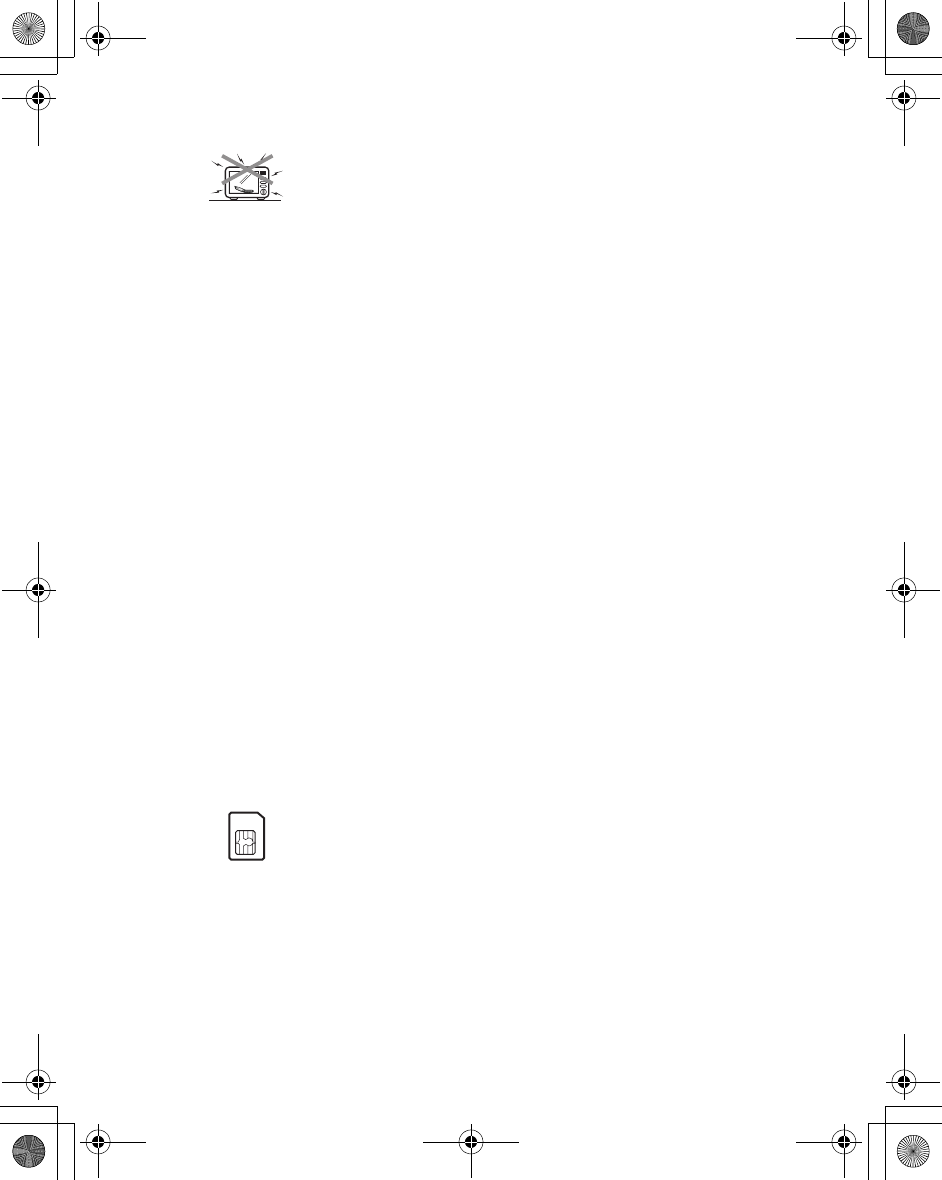
Introduction 3
When your handset, the accompanying battery or charging
accessories are wet, do not put those in any type of heating
equipment, such as a microwave oven, a high pressure
container, or a drier or similar. It may cause the battery, handset
and/or charging equipment to leak, heat up, expand, explode
and/or catch fire. Moreover, the product or accessories may
emit smoke and their electrical circuits may become damaged
and cause the products to malfunction. Panasonic is not
responsible for any and all damages, whether direct or indirect,
howsoever caused by any misuse.
The colour liquid crystal display (LCD) uses high-precision
production technology, and in certain circumstances pixels may
appear brighter or darker. This is due to characteristics of the
LCD and is not a manufacturing defect.
This equipment should only be used with Panasonic approved
accessories to ensure optimum performance and avoid
damage to your phone. Panasonic is not responsible for
damage caused by using non-Panasonic approved
accessories.
This phone must be used in compliance with any applicable
international or national law or any special restrictions
governing its use in specified applications and environments.
This includes but is not limited to use in hospitals, aircraft, whilst
driving and any other restricted uses.
It is recommended that you create a copy or backup, as
appropriate, of any important information and data which you
store in your phone’s memory. In order to avoid accidental loss
of data, please follow all instructions relating to the care and
maintenance of your phone and its battery. Panasonic accepts
no liability for any and all losses howsoever arising from any
loss of data, including but not limited to direct and indirect
losses (to include, but not limited to consequential loss,
anticipated savings, loss of revenue).
Backup
Copies and
Security
Heating
Equipment
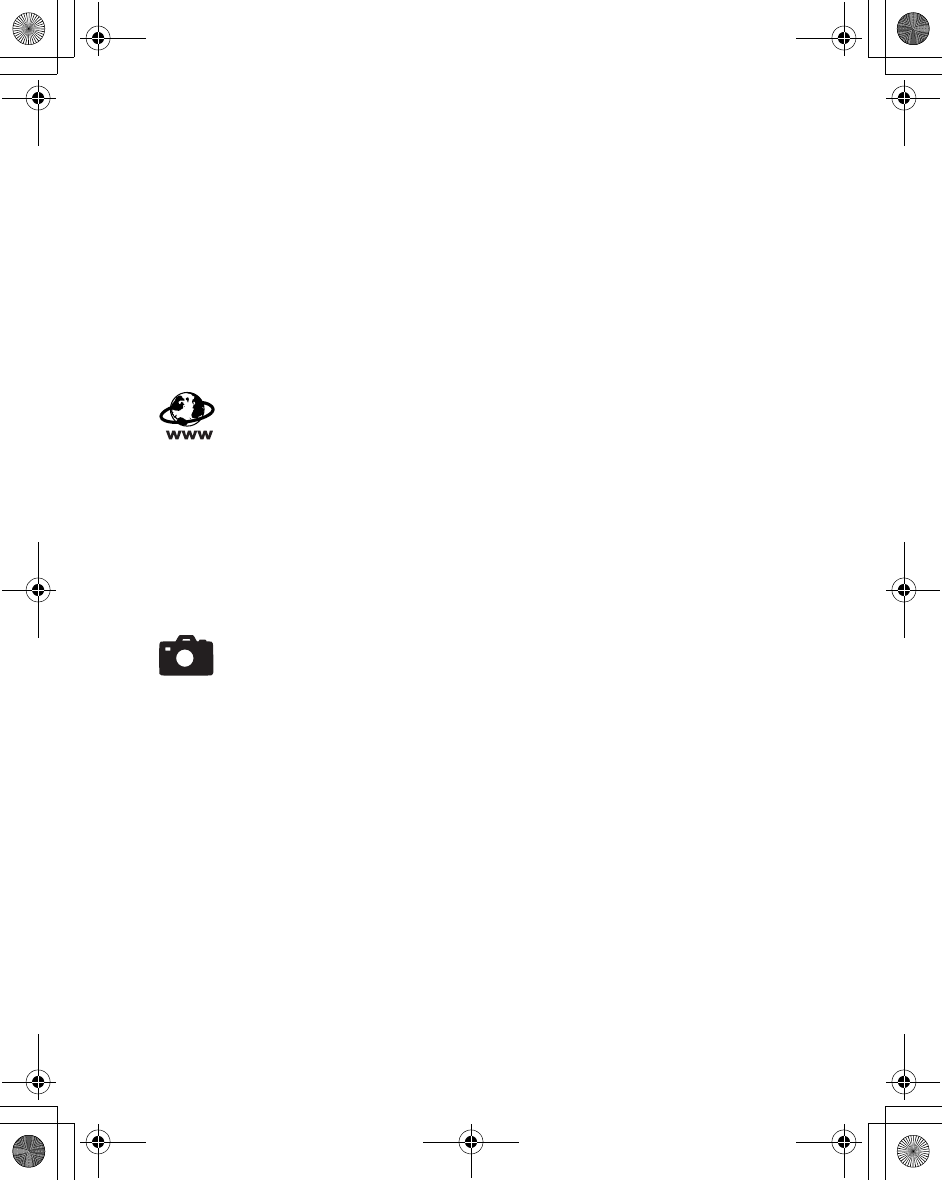
4 Introduction
Your phone has the capability of storing and communicating
personal information. It is recommended that you take care to
ensure that any personal or financial information is stored
separately from your phone. You should use security features,
such as the SIM lock to protect information held in your phone.
Panasonic accepts no liability for any and all losses howsoever
arising from any loss of data, including but not limited to direct
and indirect losses (to include, but not limited to consequential
loss, anticipated savings, loss of revenue).
Your phone has the capability of downloading and storing
information and data from external sources. It is your
responsibility to ensure that in doing this you are not infringing
any copyright laws or other applicable legislation. Panasonic
accepts no liability for any and all losses howsoever arising from
any loss of data or any such infringement of copyright or
intellectual property rights, including but not limited to direct and
indirect losses (to include, but not limited to consequential loss,
anticipated savings, loss or revenues).
You are advised to take appropriate care over the use of the
internal camera. It is your responsibility to ensure that you have
permission to take photographs of people and objects and that
you do not infringe any personal or third party rights when using
the camera. You must comply with any applicable international
or national law or other special restrictions governing camera
use in specific applications and environments. This includes not
using the camera in places where the use of photographic and
video equipment may be prohibited. Panasonic accepts no
liability for any and all losses howsoever arising from any
infringement of copyright or intellectual property rights,
including but not limited to direct and indirect losses.
The display layouts and screenshots within this document are
for illustrative purposes and may differ from the actual displays
on your phone. Panasonic reserves the right to change the
information in this document without prior notice.
Downloading
Camera

Introduction 5
This Panasonic mobile phone is designed, manufactured and
tested to ensure that it complies with the specifications covering
RF exposure guidelines applicable at the time of manufacture,
in accordance with EU, USA FCC, and Australian ACA
regulations.
Please refer to our website for latest information/standards and
compliance in your country/region of use.
http://www.panasonicmobile.com
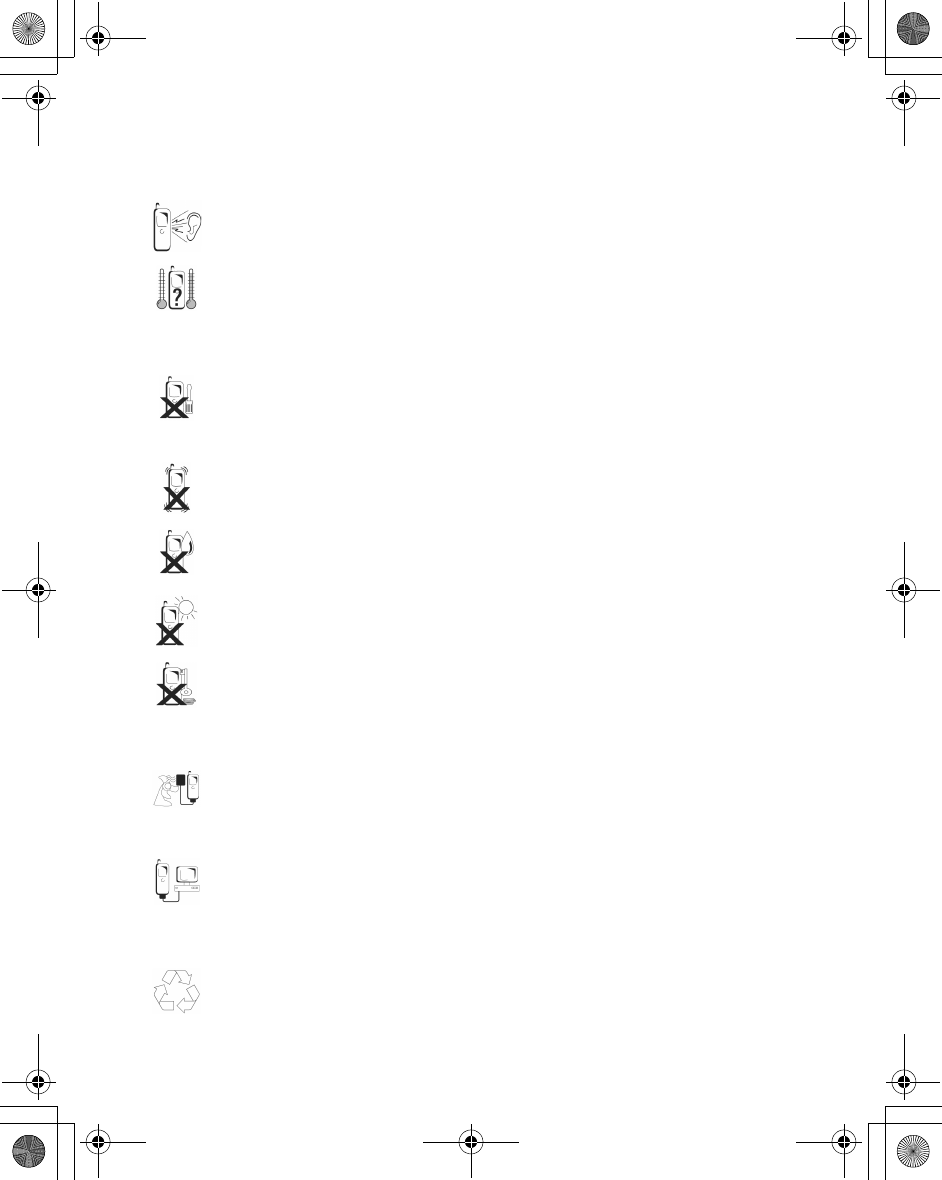
6 Introduction
Care and Maintenance
Pressing any of the keys may produce a loud tone. Avoid holding
the phone close to the ear while pressing the keys.
Extreme temperatures may have a temporary effect on the
operation of your phone. This is normal and does not indicate a
fault.
If you use the phone for a long time in temperatures over 40°C, the
display quality may deteriorate.
Do not modify or disassemble the equipment. There are no user
serviceable parts.
Do not subject the equipment to excessive vibration or shock.
Do not drop the battery.
Avoid contact with liquids. If the equipment becomes wet
immediately remove the power and contact your dealer.
Do not leave the equipment in direct sunlight or a humid, dusty or
hot area. Never throw the battery into a fire. It may explode.
Keep metallic items that may accidentally touch the terminals away
from the equipment. Batteries can cause property damage, injury,
or burns if terminals are touched with a conductive material (for
example, metal, jewelry, keys, etc.)
Always charge the battery in a well ventilated area, not in direct
sunlight, between +5°C and +35°C. It is not possible to recharge
the battery if it is outside this temperature range.
When connecting the phone to an external source, read the opera-
ting instructions of the equipment for the correct connection and
safety precautions. Ensure the phone is compatible with the
product it is being connected to.
When disposing of any packing materials or old equipment check
with your local authorities for information on recycling.
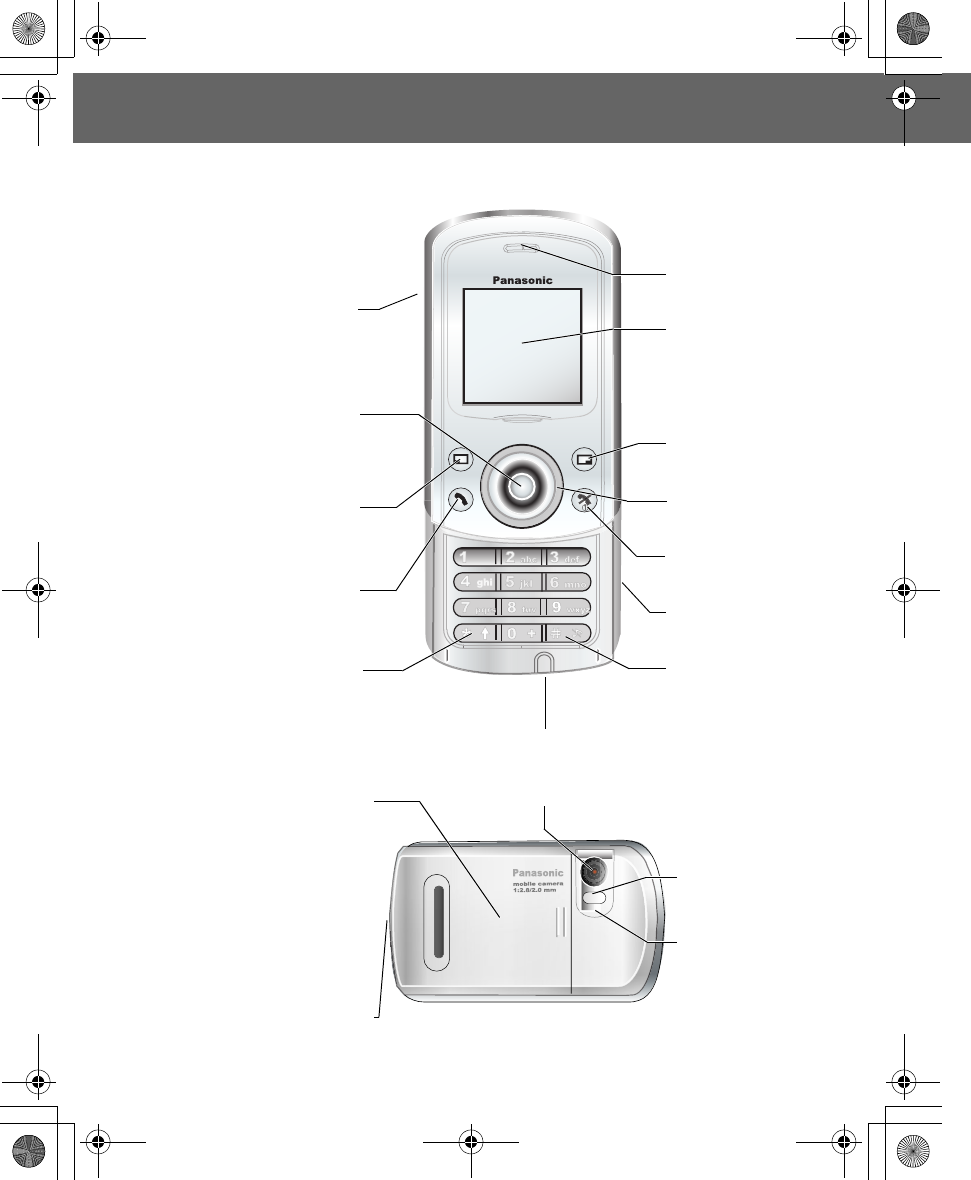
Appearance 7
Appearance
Part Names and Functions
Earpiece
Display
Left Soft Key
Right Soft Key
Navigation Key
Power/End Key
Shutter Key
Microphone
Headset Connector
Call Key
Sharp/Silent KeyAstarisk/Shift Key
Camera Lens
Photo Light
Battery cover
Connectror
Center Soft Key
Self-portrait
Mirror
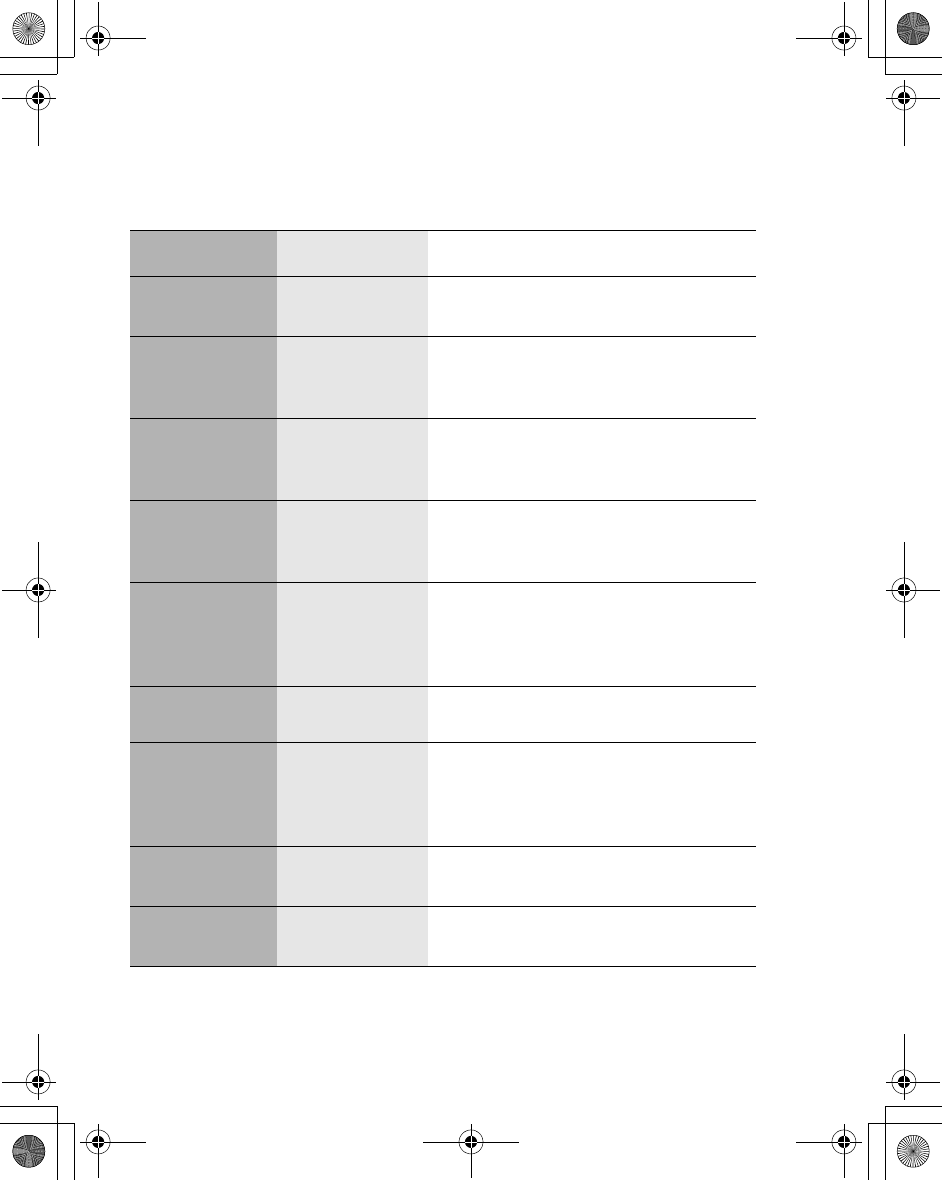
8 Appearance
Keys and Symbols
Keys Names Description
<Center Key Press center of the Navigation key to
select or enter the menu options
05137 Navigation Key
Direction which the user can move
around the display screen using the
Navigation key
ALeft Soft Key
Perform the functions indicated by text
shown in the lower left corner of the
display
@Right Soft Key
Perform the functions indicated by text
shown in the right corner of the
display
$ - #Numeric Keys
Enter numbers
Mainly used to cancel or return to the
previous menu level
Hot key dialling
CCall Key Press to answer or make a call
DPower/End Key
Press to end a call or return to Idle
screen
Press and hold to switch the phone
on or off
ESIM Indicates that the function is SIM
dependent
FNetwork Indicates that the function is Network
dependent
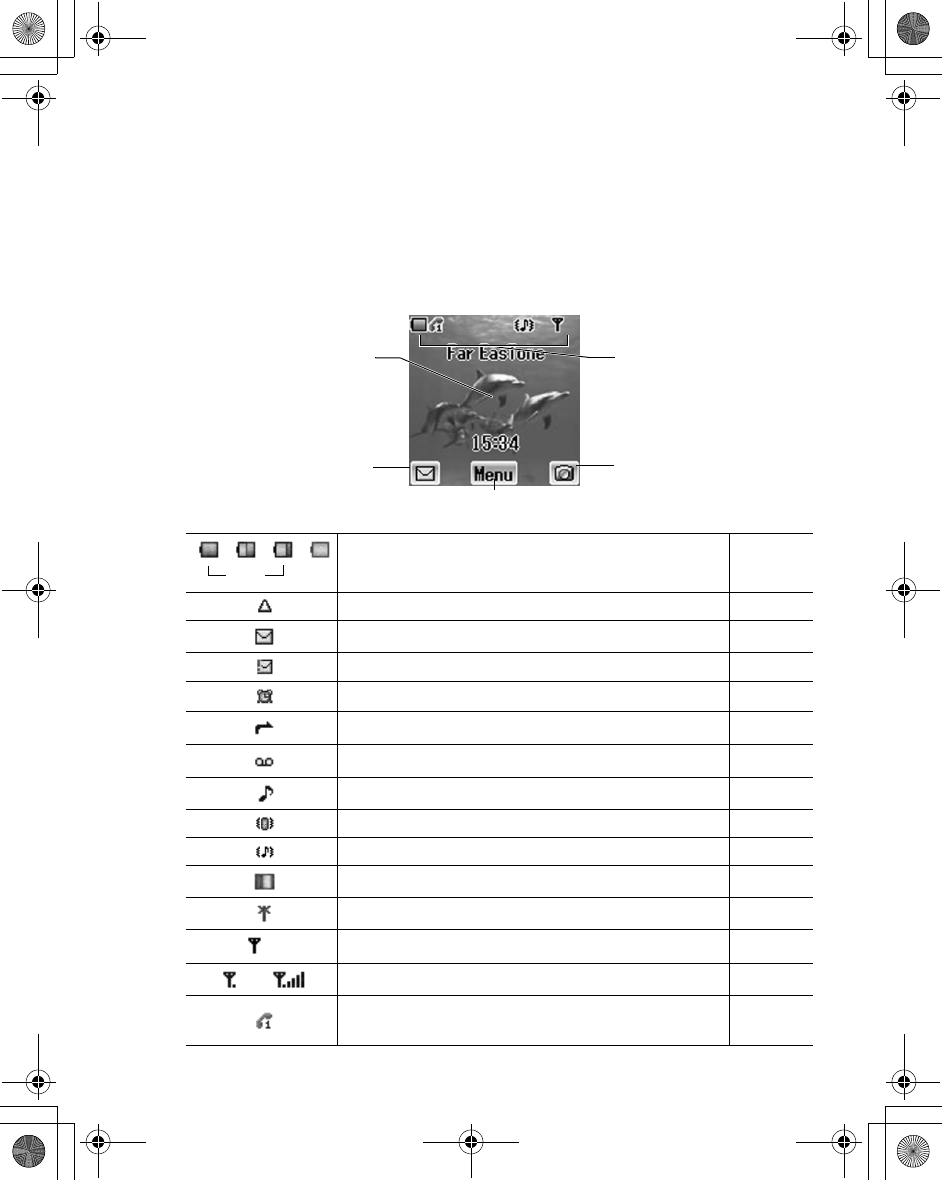
Appearance 9
Icons
Status Icons
The status icons are displayed according to the currently activated functions.
The Antenna, Signal and Battery icons are displayed when the handset is
switched on and connected to a network.
- - - Indicates Battery Level page 15
On non-home network – Roaming
Received new messages
Media Folder is full
Alarm is set
Call Divert is enabled
Voicemail activated
Ringer is enabled
vibration mode
vibrate + ring
flashing mode
GPRS service available
Only emergency calls available
- GSM signal strength
Connected to Line 1 phone number (SIM
dependent)
Status IconsIdle Screen
Left Soft Key
Center Soft Key
Right Soft Key
Green Red
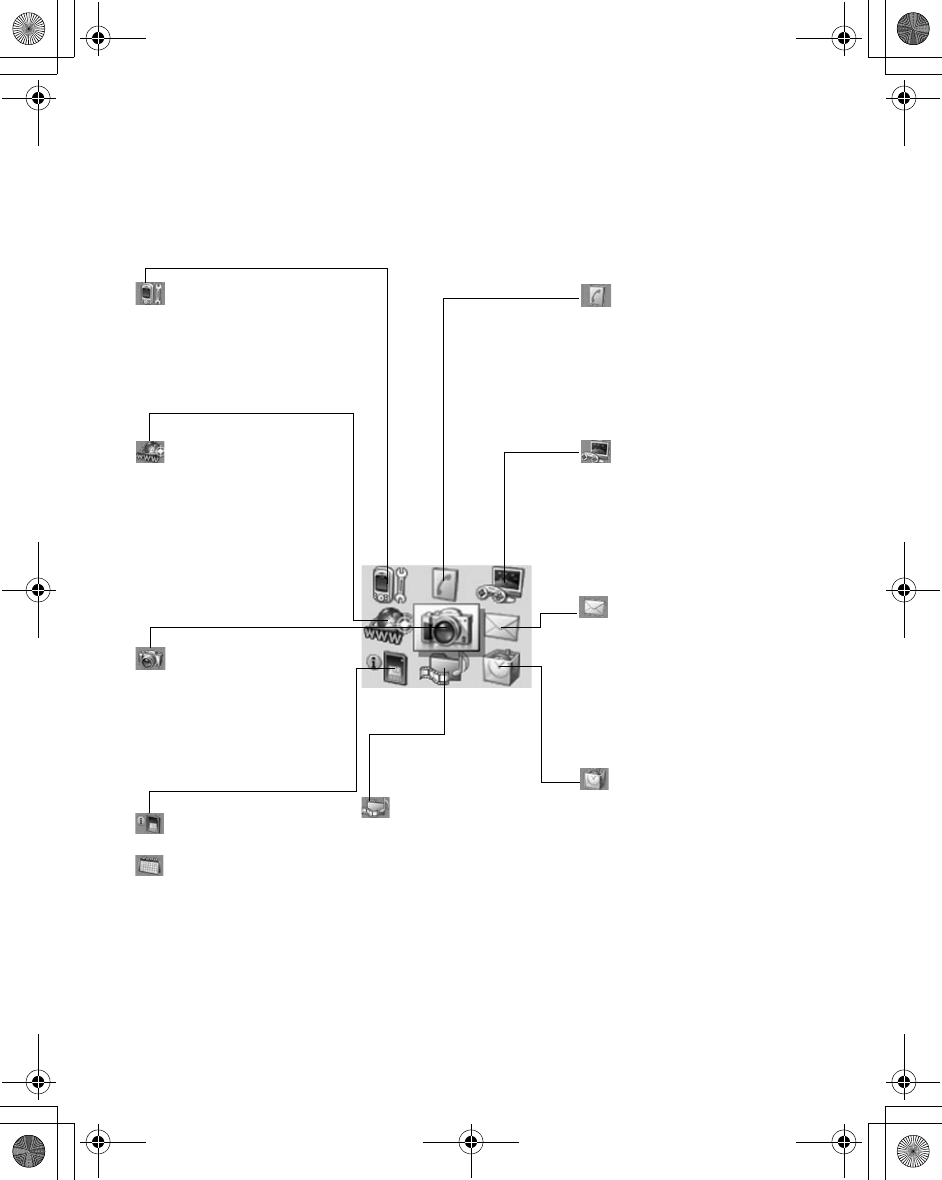
10 Appearance
Display
The menu system provides the means for accessing all the functions that do not
have their own dedicated buttons on the keypad.
My Phone
Customize the phone for
yourself.
Set Language, Ringtone or
Display settings, etc.
Browser
Access and surf the
Internet.
Configure network settings.
Contacts
Create and manage your
Contacts.
Group the Contacts
numbers for private use or
business use to find them
easier or to identify them by
ring tone.
My Media
Store your multimedia
datas.
Downloaded animations,
self-composed melodies or
photos taken by built in
Camera.
Camera
Choose from Land scope
mode and Portrait scope
mode.
Edit your photos with
various Frames.
STK (SIM Tool Kit)
Calendar
When STK is not supported
Calender will be displayed.
Applications
Various preinstalled
applications.
Compose your own
ringtone.
Set the Alarm to remind you
important schedule.
Use recorder for voice
memo.
Messages
Create and manage your
Messages.
Send multimedia messages
to your friends.
SMS/EMS and MMS are
available.
Send your message to the
world with e-mail.
Games & Apps
Download more to make
your phone unique.
Download games, useful
applications or utilities.
Downloading any
applications are network
dependent.
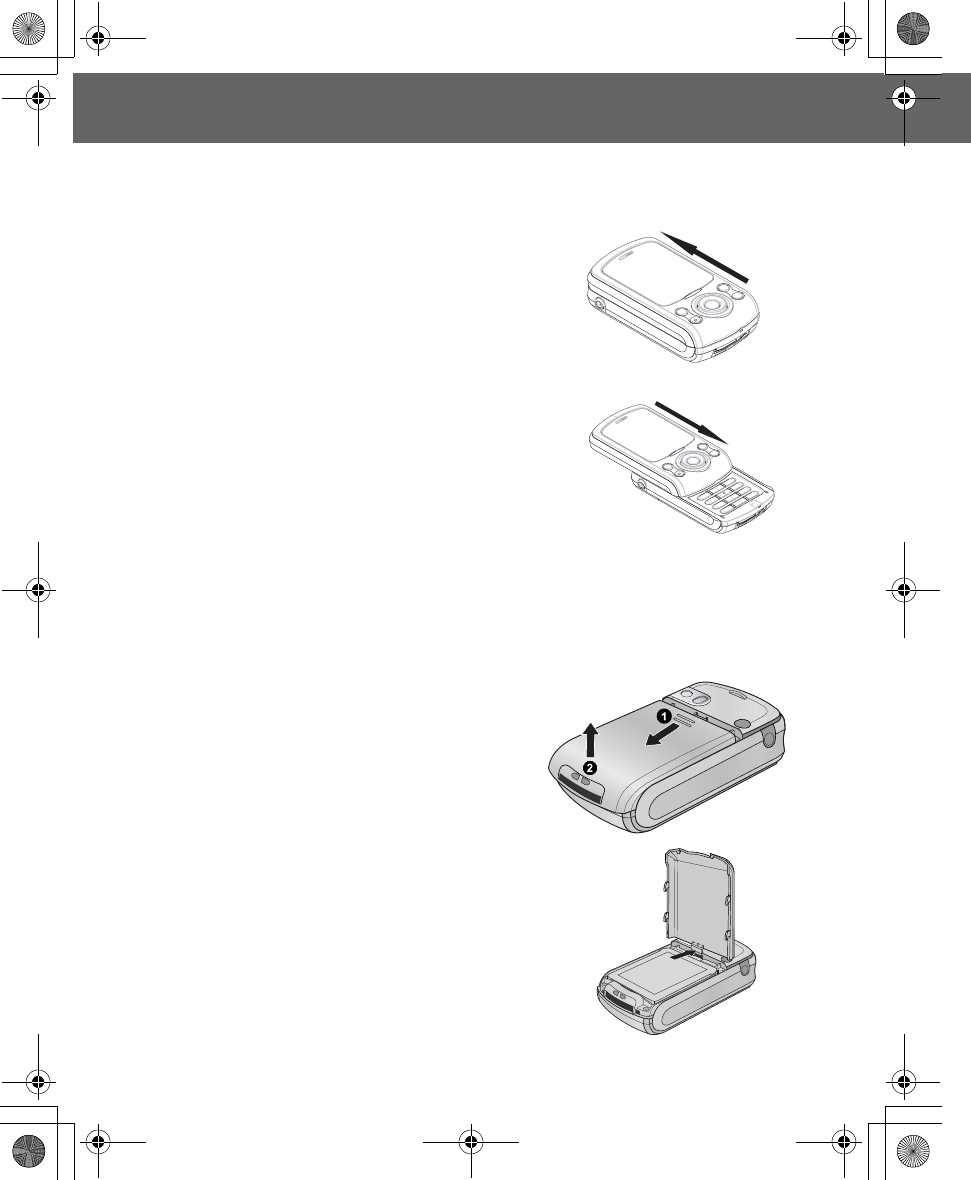
Getting Started 11
Getting Started
Phone Body
Open
1. Hold the phone body in your hand
2. Put your thumb on the protruding
portion above the Navigation key
3. Slide up the upper body of the phone
slowly
Close
1. Hold the phone in your hand
2. Put your thumb on the protruding
portion above the 0
3. Slide the upper body of the phone
down gently
Battery Cover
Before opening the cover, ensure the phone is switched off and the charger is
disconnected from the phone.
Open
1. Hold on the phone body not to move
2. Push the upper edge of the cove
3. Slide the cover down slowly
4. Move the cover off
Close
1. Put the cover on the battery
2. Slide up the cover till it fits
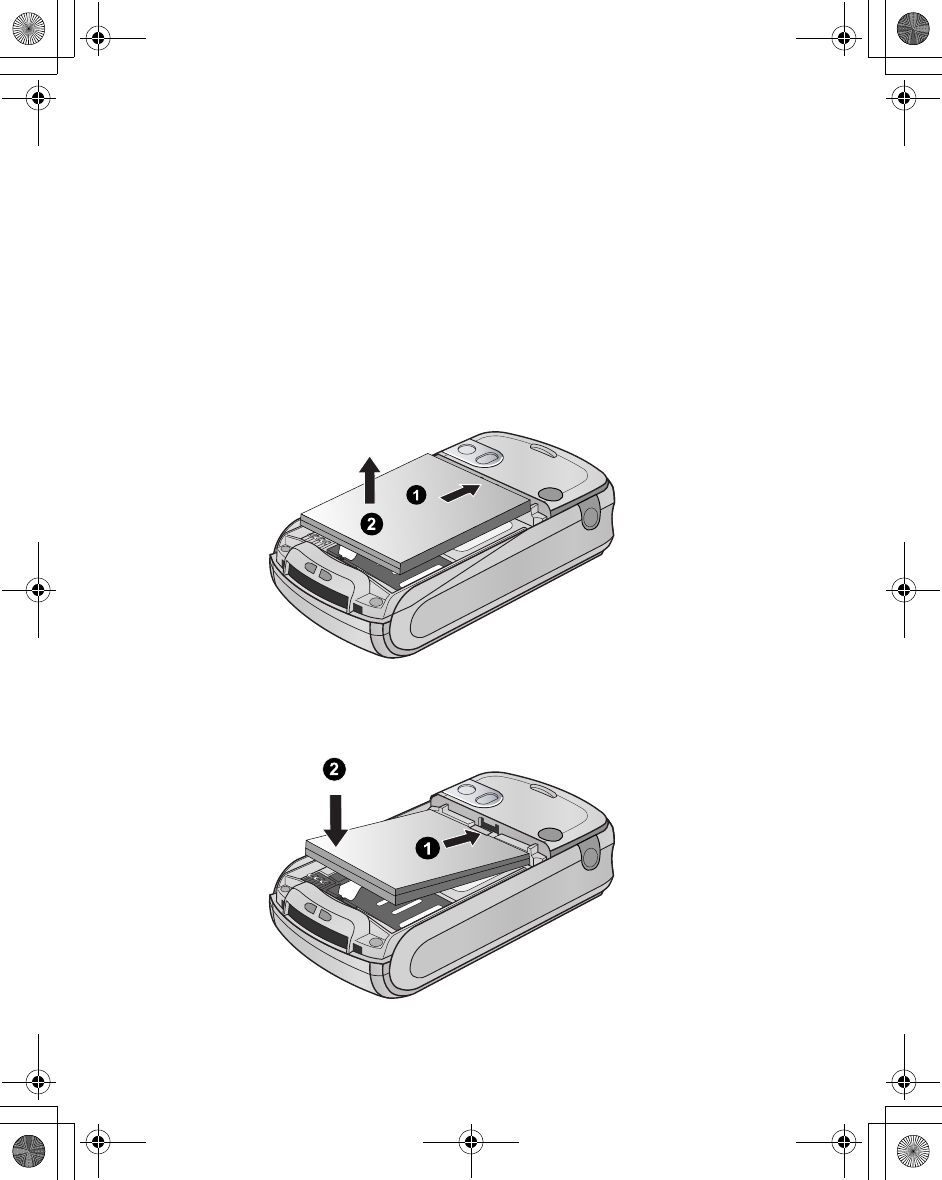
12 Getting Started
Battery and SIM
Before opening the cover, ensure the phone is switched off, the phone body is
closed and the charger is disconnected from the phone.
Battery
Removing
1. Remove the battery cover (see “Battery Cover” on page 11)
2. Place your finger on lower part of the battery
3. Push toward the upper edge of the battery till it clicks
4. Move the battery up to remove
Attaching
1. Place the upper edge of the battery first (see “Battery Cover” on page 11)
2. Push the lower edge of the battery gently till it clicks
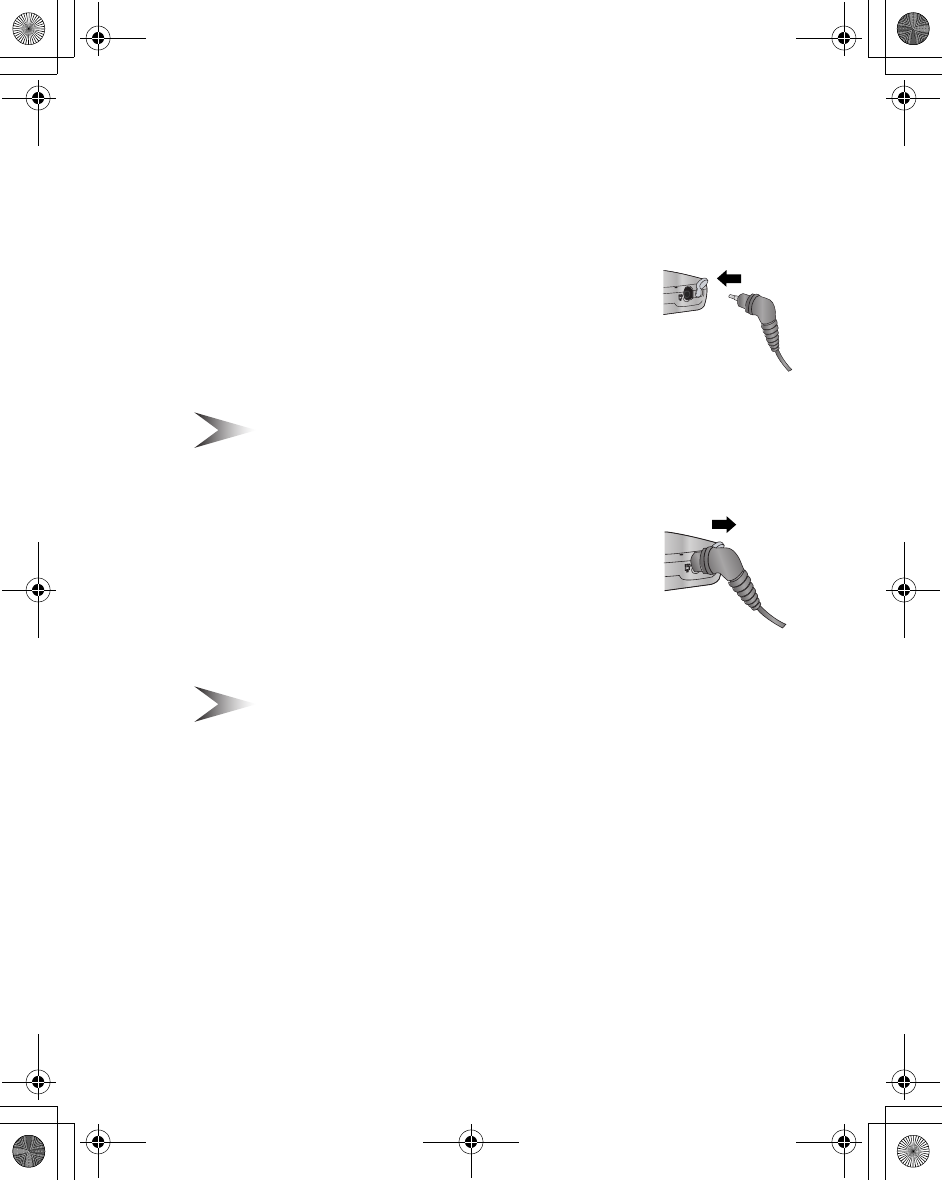
Getting Started 13
Charging the battery
Ensure the battery is attached before the charger plugged.
DO NOT force the connector as this may damage the phone and/or the charger.
Plug in
1. Face the arrow mark of the charger up
2. Plug the charger all the way in to the connector
3. Battery level indicator will start (see “Battery level
indicator” on page 15)
Note: It is recommended to charge the battery for a minimum of 4 hours
before first use.
Plug out
1. Hold the plug of the charger
2. Plug out the charger gently from the connector
Note: DO NOT pull the cable as this may damage the phone and/or the
charger.
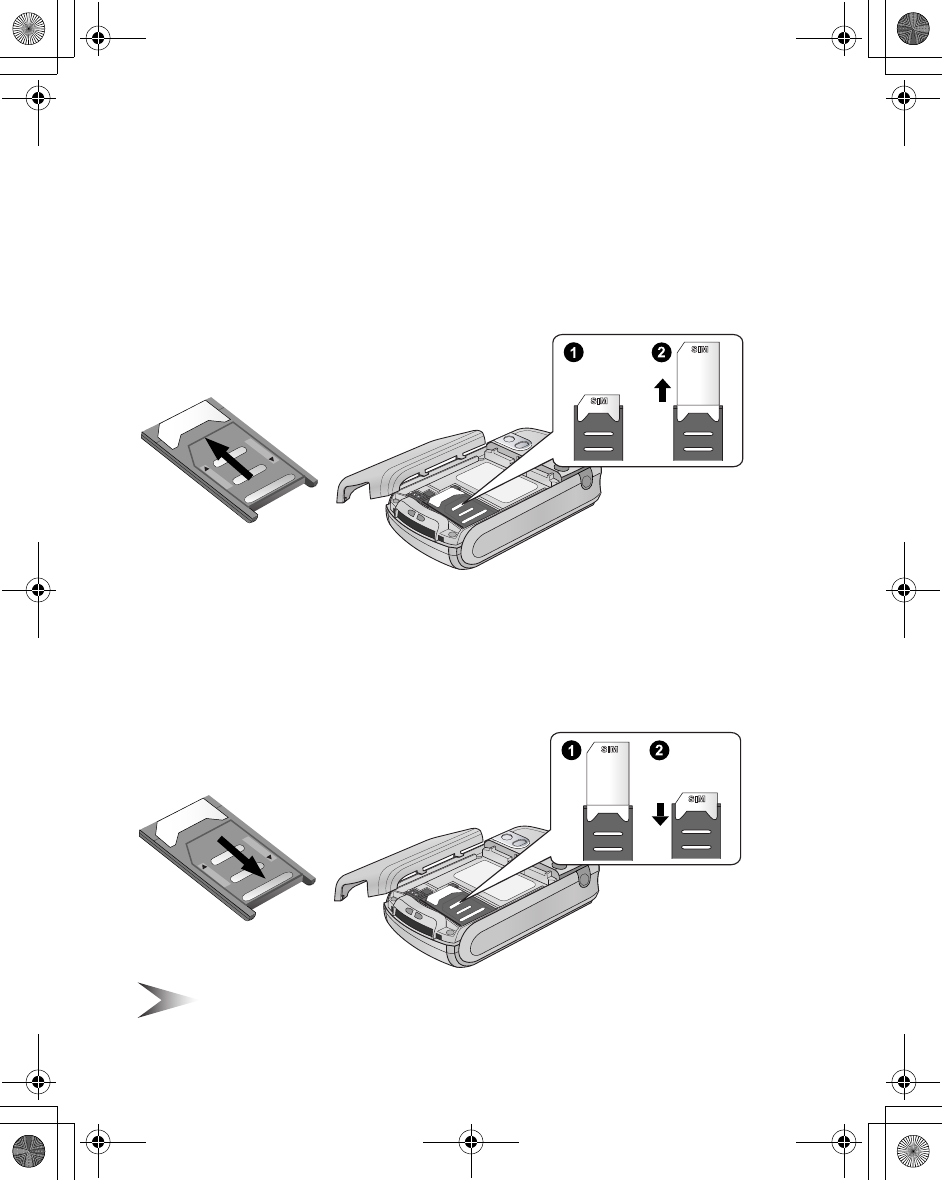
14 Getting Started
SIM
Removing
1. Remove the battery component cover and the battery
2. Move the SIM retainer right till it clicks
3. Rise the whole SIM and retainer up
4. Pull the SIM out
5. Place the SIM retainer back
Attaching
1. Remove the battery component cover and the battery
2. Rise the SIM retainer up
3. Place the SIM in the SIM retainer
4. Lay the SIM retainer down
5. Move the SIM retainer left till it clicks
Note: Ensure the golden metal parts of the SIM and the phone body are
facing each other.
OPENllll
llllLOCK
OPENllll
llllLOCK
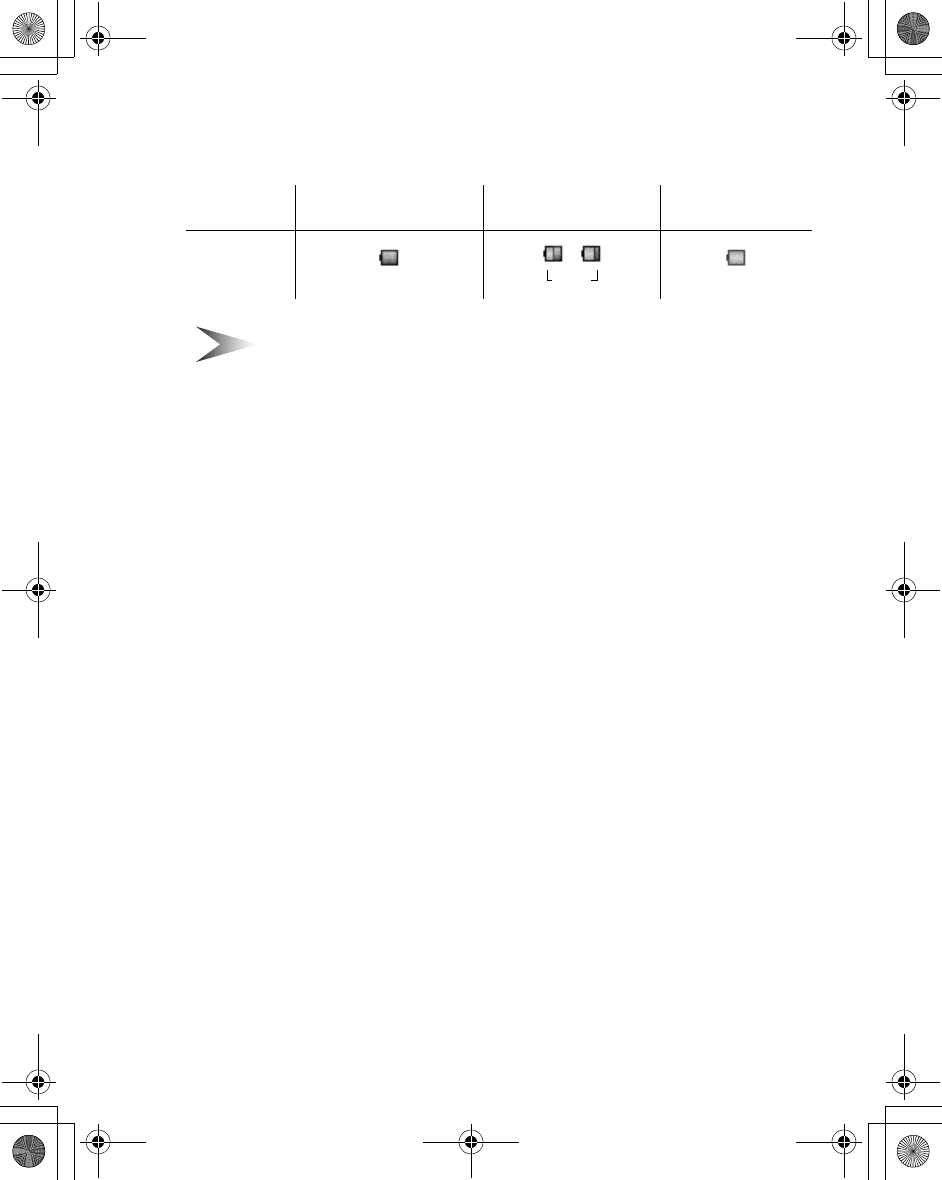
Getting Started 15
Battery level indicator
Note: It is recommended that the battery is fully discharged between
charges to maintain optimum battery life and performance.
Low battery warning
When the battery power is low, the battery indicator will be coloured red. If
battery power is critically low, a warning tone will beep. After 3 minutes from the
beep, the power will automatically shut of. Plug the charger immediately (see
“Charging the battery” on page 13). Calls can be made and received while the
phone is charging.
Charging complete While charging Battery low
Indicator Green
-
Red
Green
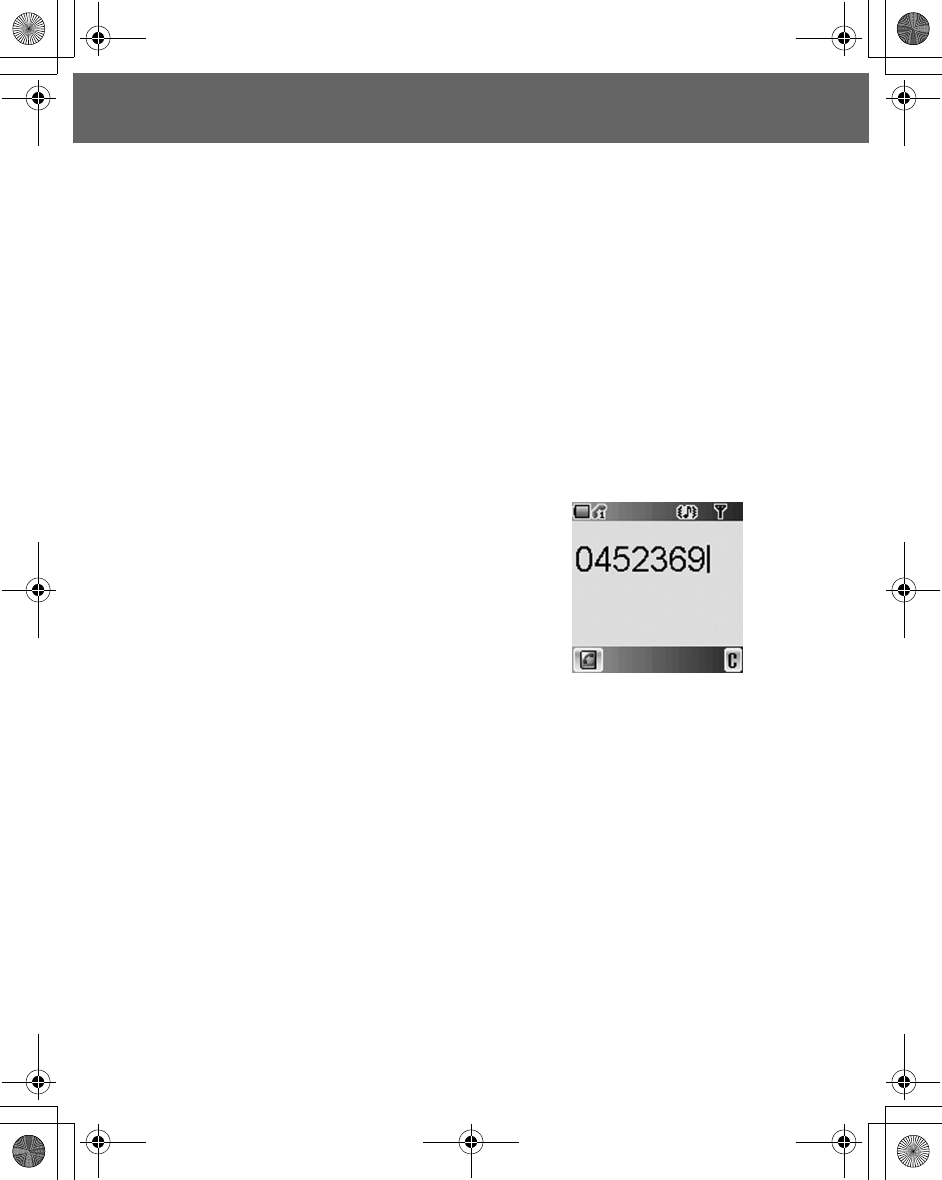
16 Basic Operations
Basic Operations
Switching ON/OFF
To Switch ON/OFF the phone, the phone body must be opened.
1. Press and hold D(Power) for 2 to 3 seconds
2. Startup animation will start
3. Customizable Greeting (see “Greeting” on page 34) will be displayed for
2 seconds
4. The display will be stayed in Idle screen
Making a Call
Ensure the phone body is opened, the phone is switched on and the signal
strength meter shows network coverage is available in the current area.
Entering numbers
You need to have the area code and the phone
number before you call.
In idle screen
1. Enter the area code and phone number # -
,
2. The dialled number is displayed
3. Press C(Call)
Ending a call
When you end a call, the duration of the call will be displayed. If the Max Cost
(see page xx) is setted, the remaining units will be displayed also.
While on a call
1. Press D(End)
2. Duration is displayed
3. Max Cost is displayed (when setted)
see max cost
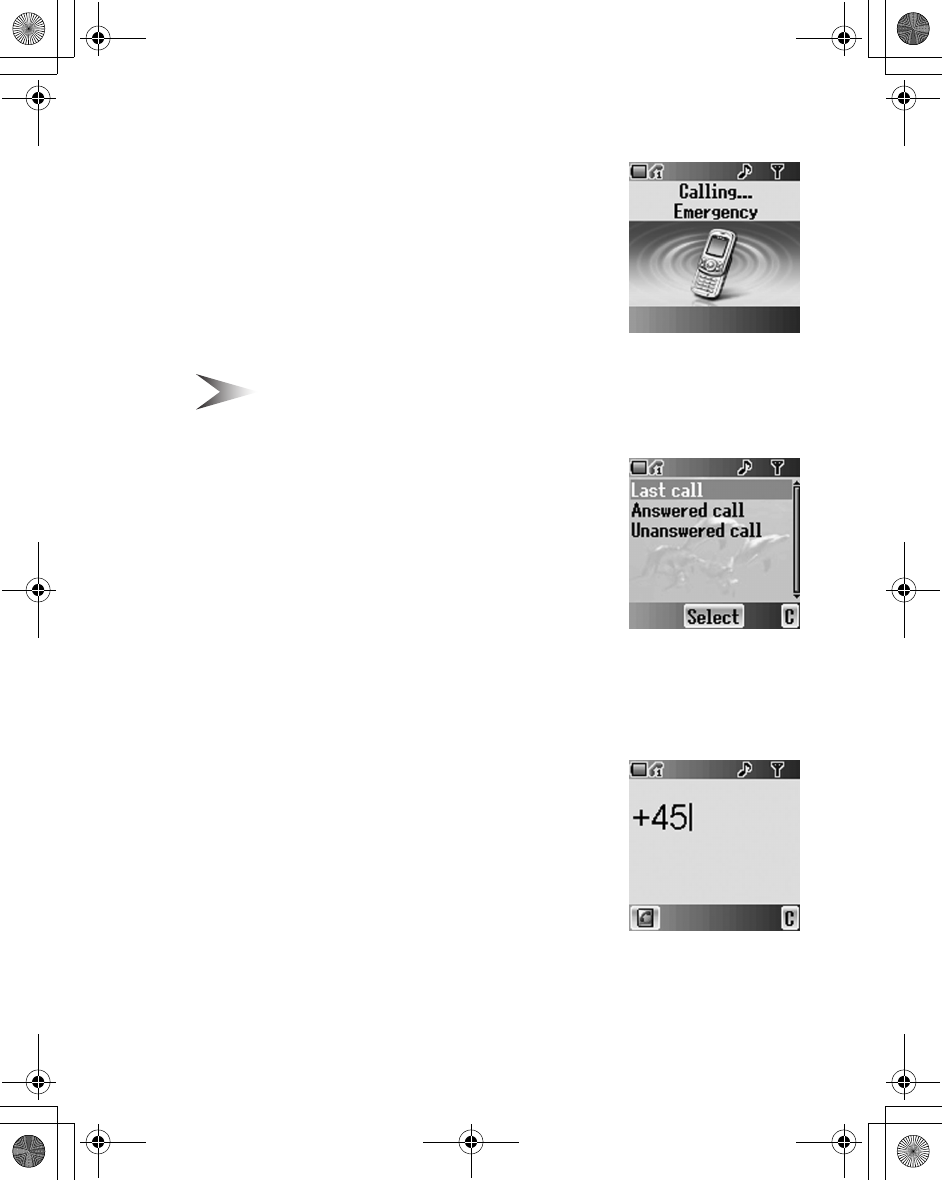
Basic Operations 17
Emergency call
In emergency you can make an emergency call with
dialling international emergency number 112 which is
adopted by most countries. Even when SIM is not
attached to the phone, this function is available in
most.
In idle screen
1. Enter 112 # - ,
2. Press C(Call)
Note: Making emergency calls without SIM is country or network operator
dependent.
History
You can select phone numbers from Last Call,
Answered Call or Unanswered Call, and there are
recent 50 numbers in Last Call and Answered Call
each, 20 in Unanswered Call list.
In idle screen
1. Press C(History)
2. Press 4(Move) to a required list
3. press <(Select)
4. Press 4(Move) to a required number
5. Press C(Call)
International call
You need to know the destination country/region
code, area code and the phone number before you
make an international call.
In idle screen
1. Press and hold # until “+“ is displayed
2. Enter the country/region code # - ,
3. Enter the area code and the phone number # -
,
4. Press C(Call)

18 Basic Operations
Contacts
You need to store phone numbers in Contacts before
using this function (see “Contacts” on page 48).
In idle screen
1. Press 1 or 5(Contacts list)
2. Press 4(Move) to a required entry
3. Select C(Call)
Hot Key
You need to set the Hot key dial before using this
function (“Hot key dial” on page 54). To view your hot
key dial list see Hot key dial in Contacts menu.
In idle screen
1. Press and hold the appropriate hot key number
# - ,
2. The call will start automatically
Service Dial E
Your Service Provider may program some special phone numbers into your SIM
. You may not modify these numbers.
In idle mode
1. Press 1 or 5(Contacts list)
2. 4(Move) to browse the Service Dial numbers
Note: Only when SIM or All is selected at My Contacts (see my contacts on
page xx) SDN (Service Dial Numbers) will be displayed. If your operator
does not offer these services, any service numbers will not be displayed.
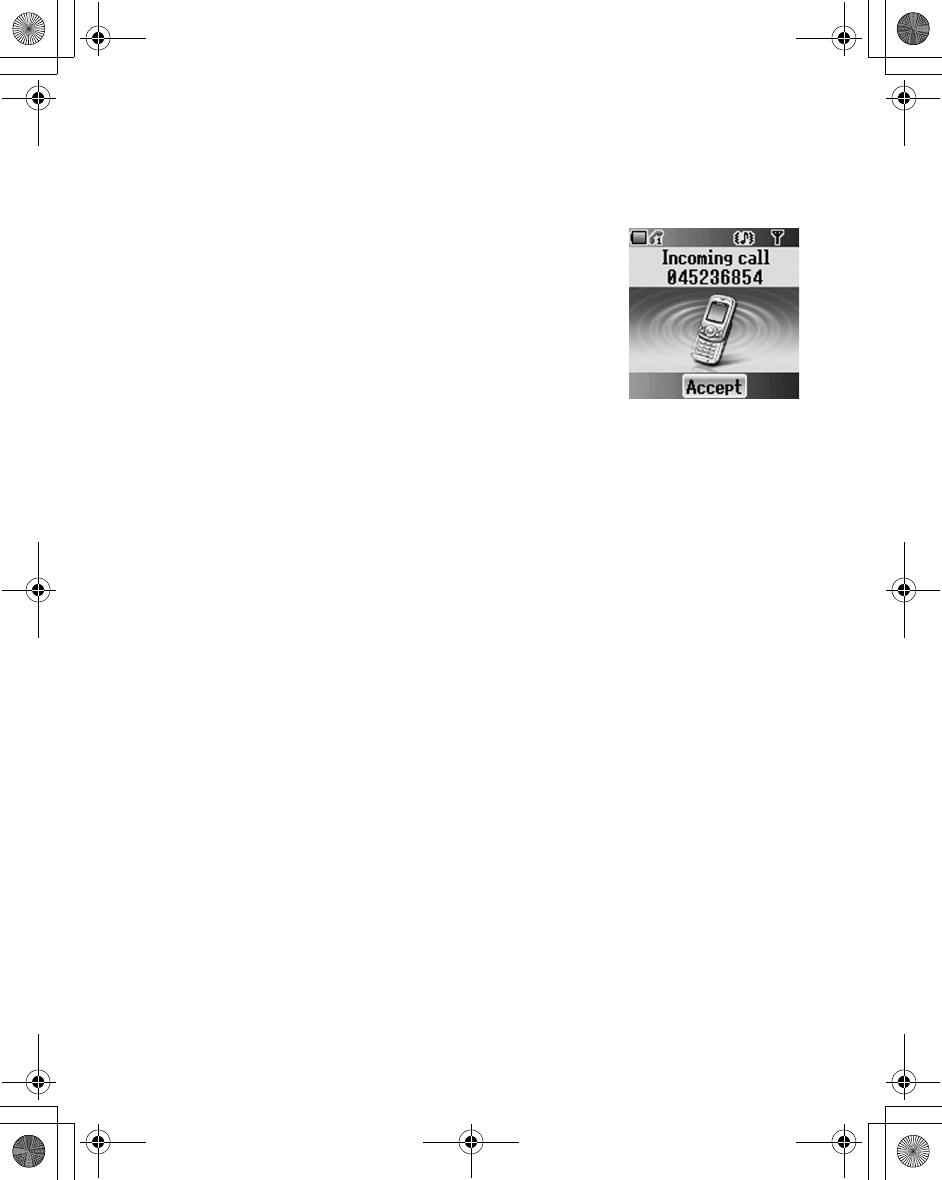
Basic Operations 19
Incoming Call
Answering
Press any key while the phone is ringing except
D(End) to answer an incoming call.
Unanswering
If calls are not answered, the number of the missed calls will be displayed. Press
any key to clear the display.
Rejecting
While the phone is ringing, press D(End) to reject the call. The number of the
missed calls will be displayed. Press any key to clear the display.
Auto Answer
When Auto Answer is switched on, and Personal Handsfree is connected, a call
will be answered without pressing any keys. Any call waiting should be
answered in normal way (see page xx).
Caller’s ID
When the phone receive an incoming call and the number is stored in Contacts,
the caller’s name and the phone number will be displayed.
Rigntone Volume
You can controll the Ringtone Volume during the phone ringing with pressing 4.
To mute, press and hold !.
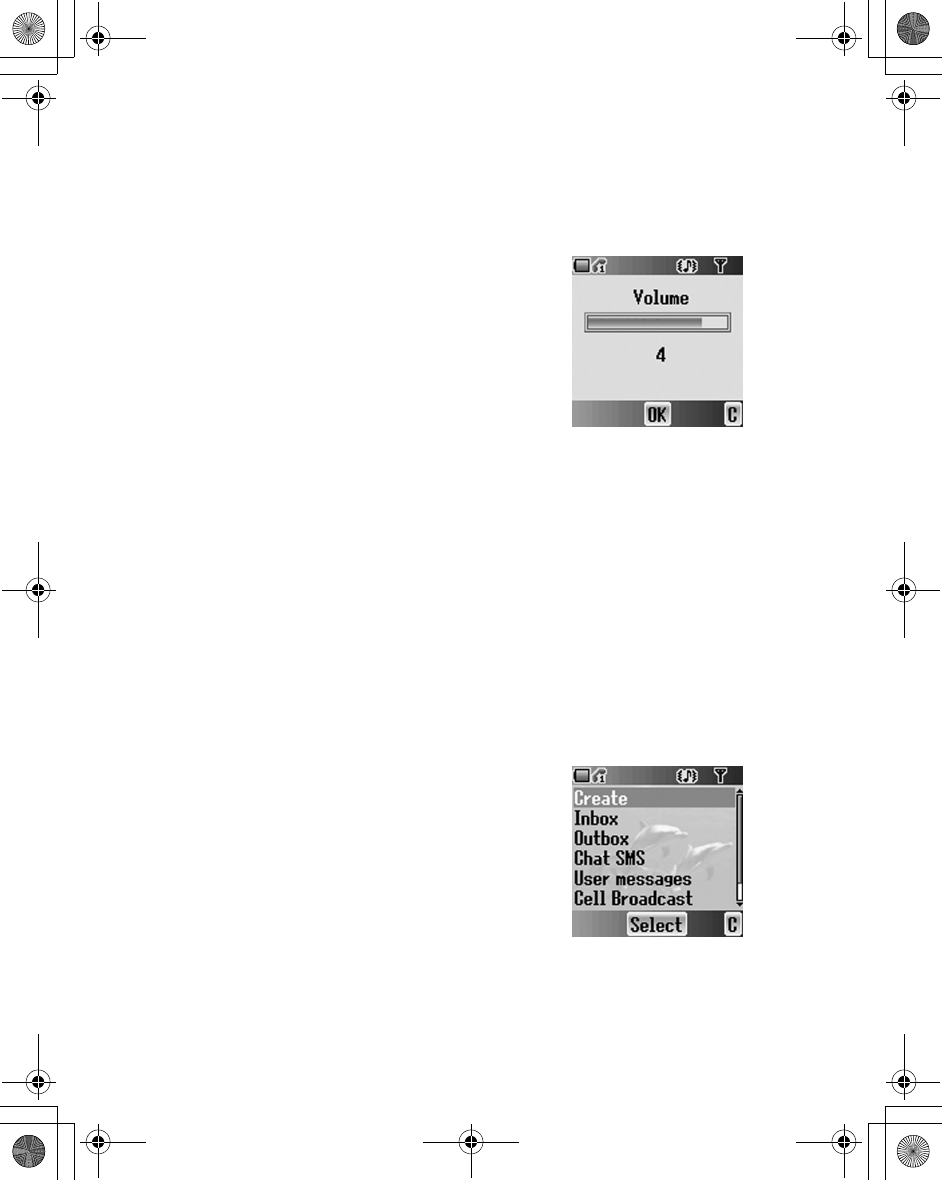
20 Basic Operations
In-call operations
You may use various functions while on a phone.
Volume controlling
You can controll the speaker volume while on a
phone with pressing 4. To mute, press @.
Holding a call
While on a call
1. Press @(Hold)
2. Press @(Hold) again to resume
Accessing Contacts
You can access the Contacts list that is stored in the SIM or the phone while on
a call.
While on a call
1. Press 1 or 5(Contacts list)
2. 4(Move) to a required entry
Messages
You can create, check or send a message while on a
call.
While on a call
1. Press A(Messages)
2. 4(Move) a required function
(see “Messages” on page 69)
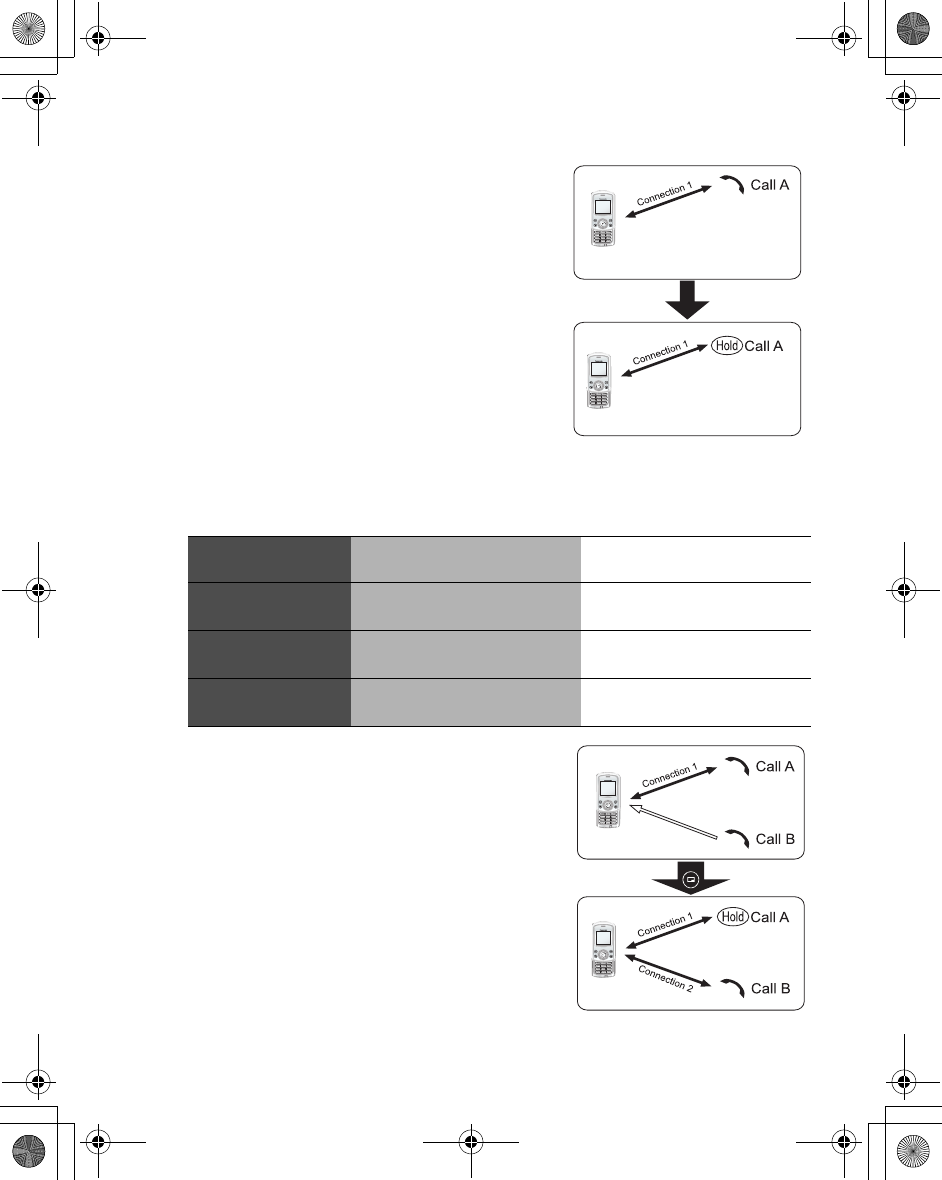
Basic Operations 21
Hold
You can put a call on hold.
While on a call
1. Press @(Hold)
To resume
1. Press @(Hold) again
Call waiting F
If Call waiting is on, you can receive another call (see “call waiting” on page xx).
Hold and answer
You can Hold a current connection and answer
a new caller.
While on a call
1. You hear a sound of new caller
2. Press @(Hold)
Current connection New connection
<Hold Connect
DEnd Connect
@Connect Reject
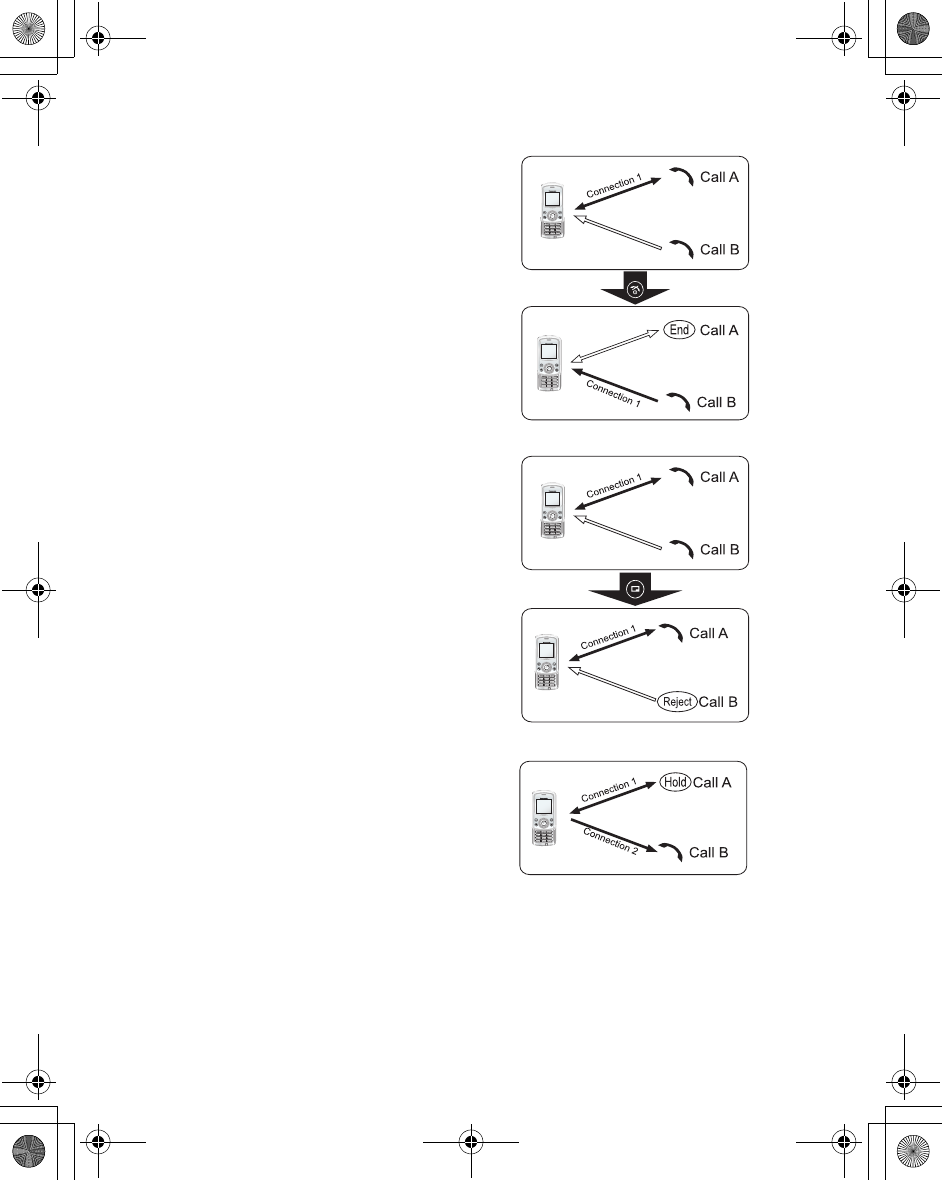
22 Basic Operations
End and answer
You can end a current connection and answer
a new caller.
While on a call
1. You hear a sound of new caller
2. Press D(End)
Reject a new caller
You can reject a new caller while you are on a
call.
While on a call
1. You hear a sound of new caller
2. Press A(Reject)
Second call
You can make another call while on a call.
While on a call
1. Enter a required phone number # - ,
OR
1 or 5(Contacts list) select required
number
2. Press C(Call)
The first call will be placed on hold
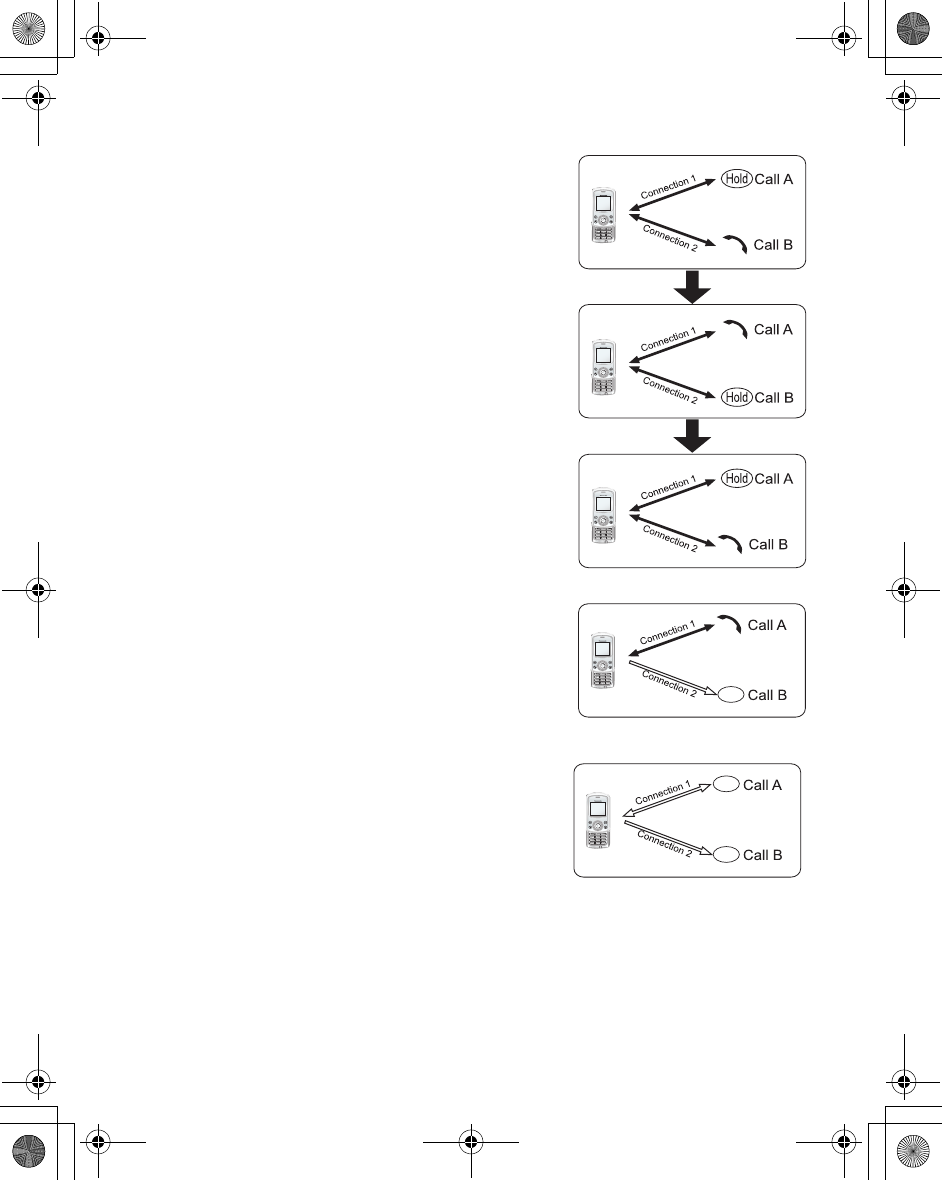
Basic Operations 23
Swapping between 2 connections
You can swap between 2 connections
While on calls
1. Press <(Select)
2. 4(Move) to Swap call
3. Press <(Select)
Ending the current connection
While on calls
1. Press <(Select)
2. 4(Move) to Hang up
3. Press <(Select)
Ending both connections
While on calls
1. Press D(End)
End
End
End